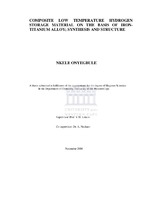| dc.description.abstract | It is widely believed that hydrogen will within a few tens of years become the means of storing and transporting energy. The reason is the depletion of hydrocarbons and the
relatively facile production of hydrogen from various renewable sources of energy. Hydrogen can be combusted in an efficient way in a fuel cell with water as emission product. As concerns over air pollution and global warming increase, the incentive to switch to clean and efficient hydrogen economy becomes greater and the transition may occur well before hydrocarbon reserves are extinct. The overall goal of the project is to develop the knowledge base for solid-state hydrogen storage technology suitable for stationary and mobile applications. In order to accomplish this
goal, the project will have a dual focus which includes the synthesis of novel nano-structured hydrogen storage materials and systems that can accurately analyze the materials. The aim of this research is to develop a novel composite hydrogen storage material with high wt% storage capacity, high intrinsic safety, appropriate thermodynamics, high mechanical strength, reversibility of the system and fast kinetics based on a well known “low temperature” intermetallic alloy (Ti/Fe) as the core. In the course of achieving this objective, the structural, thermal, chemisorptive and physisorptive attributes of this material on a nanoscale have been evaluated considering that nano-structuring is a potentially promising approach for controlling bond strength, kinetics, and sorption temperatures and pressures. By combining different materials with suitable catalytic and thermodynamic properties, a new class of hybrid hydrogen storage material has been developed. More importantly, the focus was to increase the capacity of hydrogen sorption in this material. This goal was achieved
with the mechano-chemical pre-treatment of Ti/Fe alloy and surface modification with carbon nanotubes, binary palladium and magnesium metals via a layer-by-layer modification
technique. The chemical and mechanical stability of hydrogen storage materials is of great importance because hydrogen storage materials must withstand repeated adsorption and
desorption cycles. The layer by layer approach that was used in this project allowed the investigation of the chemical and mechanical stability of the materials as each layer was
added. Through this layer by layer approach suitable nano-particles were introduced that are chemically and mechanically stable. The knowledge emanating from this investigation is expected to allow the directed design of new, higher-efficiency, recyclable hydride-based materials in pursuance of the 6.0 wt% goal set forth by the US Department of Energy. | en_US |

